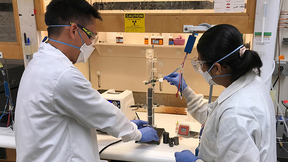Physics World names National Ignition Facility fuel gain top 10 breakthrough of the year
 (Download Image)
NIF’s target chamber is where the magic happens – temperatures of 100 million degrees and pressures extreme enough to compress the target to densities up to 100 times the density of lead are created there. Photo by Damien Jemison/LLNL
(Download Image)
NIF’s target chamber is where the magic happens – temperatures of 100 million degrees and pressures extreme enough to compress the target to densities up to 100 times the density of lead are created there. Photo by Damien Jemison/LLNL
Physics World, an international monthly magazine published by the Institute of Physics, has named the National Ignition Facility’s (NIF) achievement of fuel gain one of its top 10 breakthroughs of the year.
Ignition — the process of releasing fusion energy equal to or greater than the amount of energy used to confine the fuel — has long been considered the "holy grail" of inertial confinement fusion science. Before achieving ignition, a key step along the path is to have "fuel gains" greater than unity, where the energy generated through fusion reactions exceeds the amount of energy deposited into the fusion fuel and alpha-particle self-heating of the fusing region.
NIF — the world’s largest and most energetic laser — was the first facility to ever reach the milestone of achieving fuel gains greater than 1 with significant levels of alpha-heating. In a paper published in the Feb. 12 online issue of the journal Nature, scientists detailed a series of experiments conducted on NIF, which showed an order of magnitude improvement in yield performance over past experiments.
"Creating the conditions for sustained nuclear fusion to occur in the laboratory has proved notoriously challenging, but persevering is essential because success could lead to safe and clean sources of energy," said Hamish Johnston, editor of physicsworld.com. "By obtaining a fuel gain of greater than one, the team working at the National Ignition Facility has taken an important step toward realizing fusion energy."
The Physics World editorial team recognized the achievements from 2014 in a range of topics from nuclear physics to nanotechnology. The top 10 breakthroughs were selected using the following criteria: fundamental importance of research, significant advance in knowledge, strong connection between theory and experiment and general interest to all physicists.
Contact
 Breanna Bishop
Breanna Bishop
[email protected]
(925) 423-9802
Related Links
National Ignition FacilityViewpoint: Encouraging Signs on the Path to Fusion
High-Adiabat High-Foot Inertial Confinement Fusion Implosion Experiments on the National Ignition Facility
Design of a High-Foot High-Adiabat ICF Capsule for the National Ignition Facility
Tags
National Ignition Facility and Photon ScienceNational Ignition Facility
Lasers and Optical S&T
Lasers
Energy
Featured Articles







